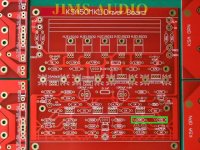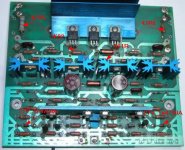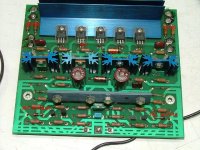I have used the PCBs from the original and second group buy, they seemed to work very well.
You asked in a couple of places why someone would build a KSA50 as opposed to a KSA100. AFAIK the main reason is heat, there is an implied scale of construction required in order to dissipate it. I started to construct a passively cooled KSA100, then later I embraced the idea of fans when I realised I would not be able to move the amp on my own.
I did not try a fully regulated power supply, the output capability of the amp is too high to make it practical, the power supply regulator has to have the same or greater current capacity or it will break, or simply not regulate. I tried a CLC power supply and it worked well...but ultimately it was not needed: sonically I did not find any meaningful differences between 40000uF, and 20000u/2mH/20000u, though I did measure lower ripple on the rails.
Soft start is easily achieved with a CL60 thermistor in series with the primary of the transformer. They have high resistance when cold and low resistance when hot. They heat up as a result of the mostly constant current flowing. IIRC the specs for the CL60 are quite appropriate for an amp of this size (50-100W class A), but not too much bigger.
HTH
Stuart
Thank you Stuart. At first, I thought, "What did I get myself into." You have made it, for me, a possible project for a retired guy. "Hey, this is doable." Now, to find the thermistor in the United States!!! The last big project I did was an oscilloscope kit for a DeVry class 35 years ago. Thanks to all you guys at diyaudio. Now to find the right PCbs. Should I trash the chinese boards or give it a go?
Are not ksa 100 MKII
xSlavic, are you saying the chinese version are not MKII?
yours are ksa 100 not ksa 100 Mk II
send private message,will include files to help built it,ONLY mainboards for a stereo amp
An externally hosted image should be here but it was not working when we last tested it.
xSlavic, are you saying the chinese version are not MKII?
I have used the PCBs from the original and second group buy, they seemed to work very well.
You asked in a couple of places why someone would build a KSA50 as opposed to a KSA100. AFAIK the main reason is heat, there is an implied scale of construction required in order to dissipate it. I started to construct a passively cooled KSA100, then later I embraced the idea of fans when I realised I would not be able to move the amp on my own.
I did not try a fully regulated power supply, the output capability of the amp is too high to make it practical, the power supply regulator has to have the same or greater current capacity or it will break, or simply not regulate. I tried a CLC power supply and it worked well...but ultimately it was not needed: sonically I did not find any meaningful differences between 40000uF, and 20000u/2mH/20000u, though I did measure lower ripple on the rails.
Soft start is easily achieved with a CL60 thermistor in series with the primary of the transformer. They have high resistance when cold and low resistance when hot. They heat up as a result of the mostly constant current flowing. IIRC the specs for the CL60 are quite appropriate for an amp of this size (50-100W class A), but not too much bigger.
HTH
Stuart
You favor using an CL60 over softstart ..? Do you find Cl60 limits dynamics in anyway ...? what about using 2 per transformer ..?
The current draw from this type of class A amp is constant as long as it remains in class A, this means, once stabilized, the temperature of the CL60 is for all intents and purposes constant, which means it's resistance is not changing...so it's hard to see how the dynamics can be impacted...
The big advantage to me was the brain dead simplicity of the CL60...We used 600VA transformers with 2 primaries (120/240v) and included a CL60 in each primary. Once installed we stopped popping the breaker, well from the inrush current anyway...we later discovered driving a short circuit would also pop the breaker ;-) These things can't really be used in direct parallel, one will tend to hog all the current, but if you have a pair of primaries they work perfectly with one in each primary.
I'm not particularly conservative, and I've done a few projects like this, so I'd build 'em. As a first time builder, if you can find anyone that has successfully used the boards, I'd build them ;-)
The cost of heatsinks, output transistors, transformers, PSU caps, chassis etc is so high that the cost of these boards and the components will ultimately not seem important.
If you are serious about the process get a variac, having the ability to turn on the amps slowly will save you a lot of grief. ;-)
Go for it
Stuart
The big advantage to me was the brain dead simplicity of the CL60...We used 600VA transformers with 2 primaries (120/240v) and included a CL60 in each primary. Once installed we stopped popping the breaker, well from the inrush current anyway...we later discovered driving a short circuit would also pop the breaker ;-) These things can't really be used in direct parallel, one will tend to hog all the current, but if you have a pair of primaries they work perfectly with one in each primary.
I'm not particularly conservative, and I've done a few projects like this, so I'd build 'em. As a first time builder, if you can find anyone that has successfully used the boards, I'd build them ;-)
The cost of heatsinks, output transistors, transformers, PSU caps, chassis etc is so high that the cost of these boards and the components will ultimately not seem important.
If you are serious about the process get a variac, having the ability to turn on the amps slowly will save you a lot of grief. ;-)
Go for it
Stuart
Of course, if you want to take the CL60 out of the equation you can simply add a relay that shorts it out after say 10 seconds...
I can't claim to have done back to back listening with and without the CL60, it was simply too much of a PITA to turn on the amp without them ;-)
Stuart
I can't claim to have done back to back listening with and without the CL60, it was simply too much of a PITA to turn on the amp without them ;-)
Stuart
xSlavic, are you saying the chinese version are not MKII?
They are exact copy of original KSA50/100mk2 and they work fine. wcleungoo has the same boards http://www.diyaudio.com/forums/solid-state/62168-my-completed-krell-ksa-50-clone-pics-2.html and I have them too (red like yours). Just be careful. They have misprint on the component side. Take a look at schematic!
I built ksa50 clone also and I'm interested, if there will be any difference between them.
Don't worry
Last edited:
ebay's chinese Ksa100mkII boards
High Power Pure Class A amplifier PCB KSA100 ! | eBay Amp
Here is the url for Jimsaudio---through ebay--- I think I paid close to $80.00 when I first found them and now Jimsaudio's store on ebay they are at $35.59.What are the misprints on the Board?
I have get the boards today and they Look Good. I Hope it doesn't make Problems to Build
High Power Pure Class A amplifier PCB KSA100 ! | eBay Amp
Jeezus, Young Man! Don't keep us in suspense young man! What is the misprint. Do be aware that if you just go ksa50 and not ksa100, there are directions at the bottom of the parts list to omit or add certain components. Or if you perfer one type of component you have follow instructions.They are exact copy of original KSA50/100mk2 and they work fine. wcleungoo has the same boards http://www.diyaudio.com/forums/solid-state/62168-my-completed-krell-ksa-50-clone-pics-2.html and I have them too (red like yours). Just be careful. They have misprint on the component side. Take a look at schematic!
I built ksa50 clone also and I'm interested, if there will be any difference between them.
Don't worry
20k and 47k resistors above 2sa970 transistors and zener diode, should be 4k7.
You just don't know how important you are today!
You are welcome, guys
Just another thing. There were some differences between KSA50mk2 and KSA100mk2 in component values.
Take a look at the pictures. First picture is KSA50mk2.
Also, KSA50mk2 had 0R5 emitter resistors for output transistors, KSA100mk2 had 1R.
But, you can leave as it is with component values from jim's audio list.
Just another thing. There were some differences between KSA50mk2 and KSA100mk2 in component values.
Take a look at the pictures. First picture is KSA50mk2.
Also, KSA50mk2 had 0R5 emitter resistors for output transistors, KSA100mk2 had 1R.
But, you can leave as it is with component values from jim's audio list.
Attachments
In the component List from jims Audio are the resistors on Output Board 1R 5W.
I have some other questions.
The current for the Output transistors Must be 650mA. Wehre can i adjust and where can i measure the current?
Measure on the 1R resistors?
Adjust with the two potentiometer on the Main Board?
Or for what are the potentiometer on the Main Board?
I Hope you can help me(and Understand my English;-) ), that is my First right diy Amp.
I have some other questions.
The current for the Output transistors Must be 650mA. Wehre can i adjust and where can i measure the current?
Measure on the 1R resistors?
Adjust with the two potentiometer on the Main Board?
Or for what are the potentiometer on the Main Board?
I Hope you can help me(and Understand my English;-) ), that is my First right diy Amp.
One potentiometer is for dc offset setting (on the bottom of the picture) and another is for bias setting (quiescent current). Yes, you must measure voltage drop on the emitter resistors and divide that value with resistors value. For the 1ohm resistor, obviously, voltage drop will be the same as the current through the resistor.
edit: KSA50 had 0R5 ohm emitter resistors, KSA100 had 1ohm. Higher value, better stability, lower value, better sound.
edit: KSA50 had 0R5 ohm emitter resistors, KSA100 had 1ohm. Higher value, better stability, lower value, better sound.
Last edited:
Ok, thanks so much.
That is a Great help.
Have someone experience with this Softstart and the Protection circuit?
AudioCreativ - Einschaltstrombegrenzung - Softstart für Ringkerntransformatoren
AudioCreativ - HighEnd 3-Kanal Lautsprecherschutzschaltung
I will buil two Mono amps with the ksa100 and i will Take this two boards per Channel to Protect the speaker and for Softstart. Two Protect speaker i Take all three relay parallel.
That is a Great help.
Have someone experience with this Softstart and the Protection circuit?
AudioCreativ - Einschaltstrombegrenzung - Softstart für Ringkerntransformatoren
AudioCreativ - HighEnd 3-Kanal Lautsprecherschutzschaltung
I will buil two Mono amps with the ksa100 and i will Take this two boards per Channel to Protect the speaker and for Softstart. Two Protect speaker i Take all three relay parallel.
Dual Bridge P.S.
I have read that using multiple caps rather than two big beer cans types is better, what is your take? How do you wire a dual bridge setup? Can you tell me who manufactures the CL 60s so that I can order them in the U.S.?Spurite
On both my 50wt mono,s and the 100w Krell clones I used dual bridge Power supplys.
With one bridge you really need matched caps that no one ever does anyway. The dual bridge design takes care of this right away and more.
The cost is only 1 extra bridge Use at least 35a 600v
For slow start keep it simple and use a CL 60 in line. They limit current somewhat but you,ll never notice it
This is the least costly route that works really well
The mention of fans as unreliable is bogus..., your favorite girlfriend or wife should be replaced with the word "fan" for a more accurate sentence!
Regards
David
- Home
- Amplifiers
- Solid State
- KrellClone KSA100-MKII Power Supply


